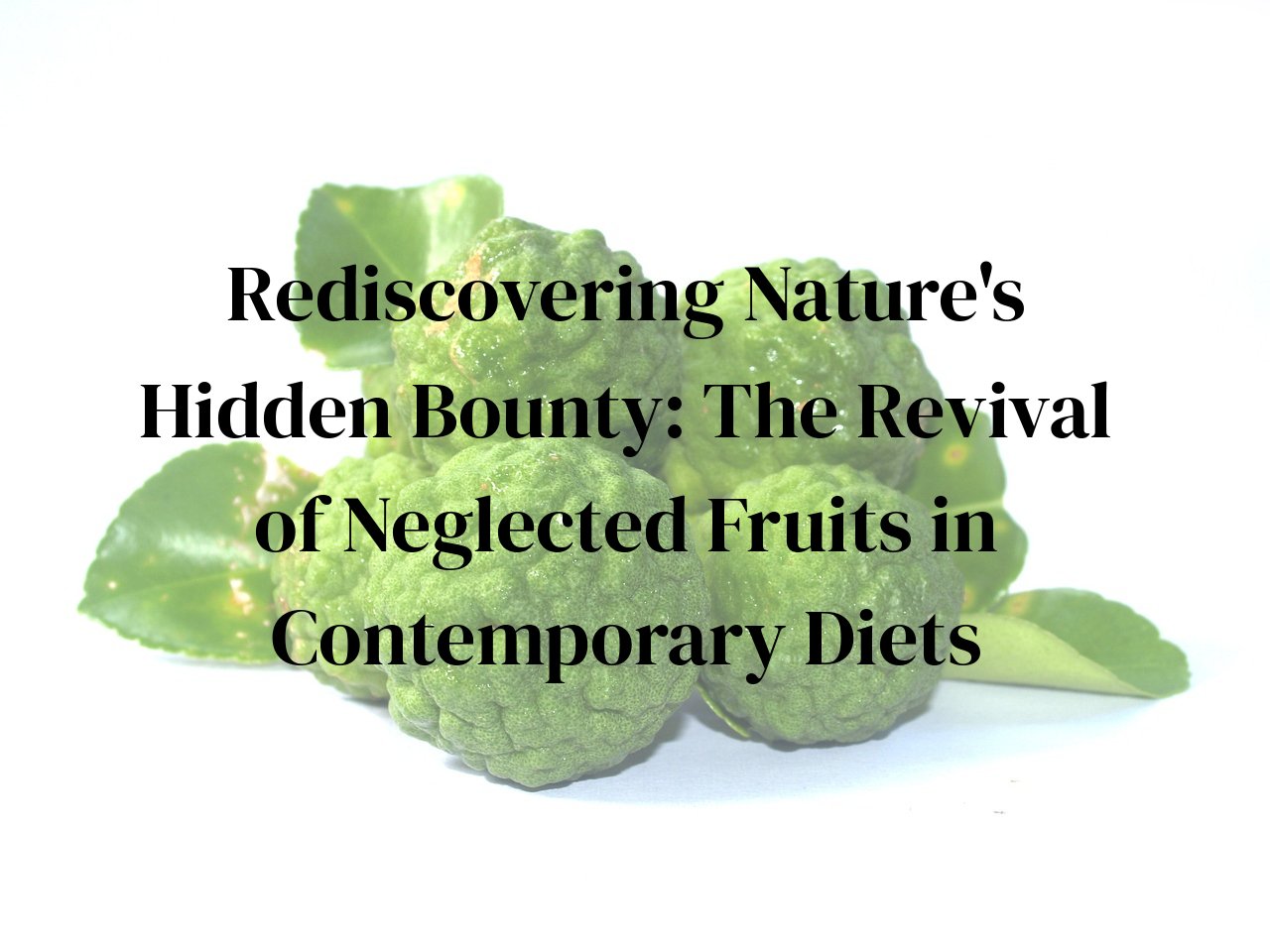
In this in-depth exploration, we embark on a gastronomic journey rekindling the essence of long-lost jewels of nature—fruits that once graced ancient tables but faded into obscurity with the march of time. This post will delve into the fascinating revival of these earthy treasures within modern nutrition. It will uncover how forgotten fruits are regaining prominence, their intriguing histories, and the plethora of health advantages they offer to contemporary diets.
Readers will not only discover the captivating stories behind these nutritional powerhouses but also learn about the implications for health, tips for incorporating them into daily meals, and the overall impact on sustainable food practices. This newfound knowledge promises to enrich your pantry and wellbeing with flavors and benefits that span through time.
Table of Contents
Historical Gems: Unearthing the Nutritional Power of Ancient Fruits
Wander with me down the forgotten orchard lanes, where nature’s hidden bounty offers a cornucopia of wellness. In my quest to embrace a healthier lifestyle, I explored the annals of horticulture and discovered fruits that ancient civilizations cherished for their medicinal and nutritional value. These fruits, often overlooked in modern markets, are teeming with antioxidants, vitamins, and minerals that can revitalize our contemporary diets and bolster our health.
One such treasure is the jujube fruit, a staple in traditional Chinese medicine, rich in vitamin C and reputed for aiding digestion and sleep. My first encounter with its sweet, apple-like flavor transported me to ancient Silk Road caravans, where it was a prized item for its purported healing properties. Another fruit, the pawpaw, indigenous to North America, was relished by Native Americans for its creamy, custard-like texture and is a powerhouse of magnesium and iron. Rediscovering these flavors not only infuses variety into my meals but weaves a tapestry of history and culture into my diet.
Amidst these, the African horned cucumber, or ‘kiwano,’ with its spiky exterior, stood out for its drought-resistant qualities and became a testament to resilience in my garden. It’s packed with vitamin A and E, showcasing that nature often hides its most potent remedies in the most unexpected packages. Similarly, the persimmon, once a staple in ancient Korean and Japanese diets, offers a rich supply of fiber and has found its way into my breakfast routine, reminding me daily that what sustained our ancestors still holds immense value in our fast-paced lives.
These ancient fruits, each with their unique story, encapsulate lessons from history, nutrition, and even personal growth. They remind me of nature’s cyclical wisdom, and the reintegration of these forgotten fruits into our diets has the potential to revive both our health and our connection with the past. Through my encounters and experiments in the kitchen, I’ve found that these historical gems are more than mere morsels of sustenance; they are beacons that lead us back to a holistic way of life, once known, now rediscovered.
Health Benefits: How Revival Fruits Fortify Modern Meals
The resurgence of ancient fruits into our diets is more than a nod to the food of our ancestors; it’s a step towards robust health. I’ve personally experienced the transformative effect of integrating fruits such as jujubes, pawpaws, and Goumi berries into my meals. Each of these forgotten treasures carry a unique set of nutrients that have fortified my modern diet in ways I did not anticipate.
Jujubes, for instance, are rich in Vitamin C and have been a game-changer for my immune system, especially during flu season. The pawpaw, with its creamy texture and tropical flavor, isn’t just a treat to the palate; it’s a source of rare antioxidants like acetogenins. The Goumi berry, a small yet mighty fruit, provides a valuable plant-based source of Omega fatty acids, essential for brain health. Their inclusion in my diet has been like discovering a natural supplement cabinet hidden within the branches of nature’s own garden.
But it’s not just about vitamins and antioxidants. In reviving these fruits, I have also reintroduced fiber diversity to my diet, essential for gut health. The native persimmon, a fruit once abundant and now overlooked, has brought gentle sweetness and fiber balance to my breakfast bowls. Its presence on my plate is a daily reminder that foods which support our digestive system are key to overall well-being.
Each meal accented with these neglected fruits becomes a complex symphony of health benefits. Through mindful inclusion, I have watched not only my physical health transform but also gained a greater appreciation for the intricate connection between our food choices and the environment. In this rediscovery, the true bounty of nature is revealed, one ancient fruit at a time.
From Orchard to Table: Integrating Lost Fruits into Your Diet
The journey of bringing forgotten fruits from orchard to table is like a thrilling expedition into both history and nature. My own culinary ventures have led me to discover a myriad of ways to enrich my diet with these nutritious, yet neglected treasures. Imagine the burst of flavor from a medlar, an ancient fruit once savored by the Greeks, now redefining my autumn desserts with its ripe, apple-like sweetness. The challenge lies not just in sourcing these fruits but in skillfully incorporating them into daily meals to reap their rich benefits.
Take, for example, the pawpaw, North America’s largest edible indigenous fruit, teeming with tropical flavors akin to banana and mango. I’ve found pawpaws to work wonders in smoothies or simply chilled as a refreshing snack. The endeavor becomes an art when intricate recipes are developed. I’ve enjoyed creating pawpaw-infused sauces or even desserts, reminiscent of cherished family gatherings under the shade of sprawling pawpaw trees, with laughter blended into the warm afternoon air.
It’s not just about experimenting in the kitchen for me; it’s a deeper communion with nature. When incorporating the tangy goodness of serviceberries or the sweet punch of juneberries into salads or baking, I am reminded of the wild bushes I stumbled upon during mountain hikes. Handpicking these fruits provided an ineffable sense of connection to the land and a mindful appreciation for the cycle of growth and harvest.
Moreover, reviving these fruits isn’t a solitary quest. I’ve engaged with local farmers, foragers, and heritage fruit enthusiasts who share my passion. This community-based approach ensures the fruits I use are sustainably sourced, often revealing a bounty of flavours from nearly forgotten varieties like the quince or elderberry. Whether making elderberry syrups for a health-boosting treat or transforming quinces into aromatic jams, each recipe tells a story—of traditions preserved and a future built on the pillars of nutritional richness and environmental mindfulness.
Ultimately, integrating these lost fruits into modern diets has transcended the boundaries of simple culinary innovation. For me, it’s a reconnection with ancestors, a nod to sustainable practices, and a celebration of biodiversity. Each bite of a rare unnamed apple variety, plucked from an heirloom orchard, becomes a narrative of taste untold in mainstream supermarkets. Through my blog and shared experiences, I hope to inspire others to embark on this delightful and meaningful gastronomic odyssey.
The Sustainability Angle: Revival Fruits and Eco-Friendly Eating
In reflecting upon the intersection of dietary choices and environmental stewardship, I discovered that incorporating neglected fruits into our diets is more than a health statement—it’s a commitment to the planet. Revival fruits, often native species or heirloom varieties, have a lower environmental impact compared to industrially-farmed staples due to their adaptability to local conditions and reduced need for chemical inputs.
Take, for instance, the small orchard I started in my own backyard, where I grow jujubes and pawpaws—fruits that were once commonplace on the tables of our ancestors. These trees require minimal intervention to thrive, illustrating how revival fruits can promote biodiversity while simultaneously cutting down on the severe ecological footprint caused by monoculture practices.
Moreover, the revival of forgotten fruits can support local economies and small-scale farmers, who are key players in preserving traditional agricultural knowledge and diversity. My frequent visits to local farmers markets have become more than just shopping trips; they are educational expeditions that connect me to my community and its agricultural heritage. By choosing these lesser-known fruits, we not only help sustain small farms but also reduce the carbon emissions associated with transporting food long distances.
Eating revival fruits also enlightens us about seasonality and curbs the demand for having every kind of fruit available year-round, an expectation that leads to energy-intensive preservation methods and transportation. It was a revelation to savor a medlar fruit, bletted to perfection, and understand that the best flavors come to those who wait for the right season—an eco-friendly principle that conserves the energy used to unnaturally hasten or delay fruit ripening.
In embracing these often overlooked gems, I have become a more conscientious consumer, learning to appreciate not just the flavors of these fruits, but also their role in a sustainable food system that respects our earth and its finite resources. Choosing revival fruits is an edible form of activism, a delicious way to advocate for a healthier world. Let us all find ways to work towards a future where forgotten fruits find their place at the center of our plates, and sustainability becomes the hallmark of our dietary choices.
The Personal Touch: My Journey with Time-Honored Fruit Discoveries
Embarking on a quest to blend historical fruits into my diet became more than a dietary change; it transformed into a deeply personal narrative, a tapestry woven with flavors, textures, and tales of yesteryears. It started with a trip to a local heritage orchard, where I first encountered the unassuming jujube fruit. As I bit into its crisp, sweet flesh, memories of ancient trade routes and traditional medicines danced in my mind, inspiring a sense of connection to my ancestors. This tiny fruit had traveled through time to grace my modern plate, offering not just nourishment, but a bridge to the past.
My next discovery was the pawpaw, a custard-like treasure native to my region, yet so often overlooked. Hosting a pawpaw tasting party, I invited friends to experience its exotic taste and shared the Indigenous and pioneer stories intertwined with its existence. Watching their faces light up with each spoonful, I realized the power these forgotten fruits had to bring people together, to offer a fresh perspective on the bounty of our natural world.
I also learned to forage and found myself walking the same paths as my forebears, gathering wild persimmons with a heightened appreciation for the land. Kneeling to pluck each orange jewel, I felt a rush of gratitude for the unadulterated sweetness provided by the earth, untouched by industrial farming. In my kitchen, crafting persimmon pudding became a seasonal ritual, a homage to the survival and resilience of these native fruits and the cultures that cherished them.
Throughout my journeys, I’ve chronicled the rediscovery of each fruit variety in vibrant blog posts and social media, sharing not just recipes but also the stories, struggles, and successes these fruits have seen through the ages. It’s been a way for me to not just influence dietary habits, but to kindle a flame of curiosity in others about the origins of the foods we eat and the legacies they carry.
As my personal fruit revival continues, it’s become clear that each fruit tells a story: of adaptation, survival, and a hint of magic. By inviting these historical gems to my table, I’m not just nourishing my body. I am reclaiming lost chapters of our collective culinary heritage and stitching them into the fabric of contemporary life—one bite at a time.
Conclusion
As the final words of this post are penned, the vibrancy and intrinsic value of these historically significant fruits echo louder in the halls of modern nutrition. The resurgence of such nutritious delights embodies more than just a dietary trend; it’s a homage to the past and a sustainable stride toward the future of our food systems. May the exploration of these resurgent fruits inspire a richer, healthier, and more diverse palette for your own culinary adventures.



